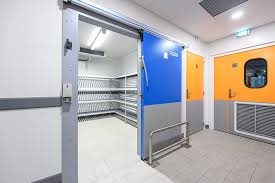A cold room is a specialized room designed to maintain low temperatures for the purpose of storing or preserving items that require such conditions. Cold rooms are used extensively in the food industry to store perishable goods, such as fruits, vegetables, dairy products, and meats, at optimal temperatures to ensure their freshness and quality. They are also used in pharmaceuticals, scientific research, and other industries where the storage of temperature-sensitive materials is critical.
Cold rooms are designed to maintain a constant low temperature, typically between -40°C and +10°C, depending on the specific application. This is achieved by using specialized insulation materials and refrigeration systems to control the temperature and humidity inside the room. The insulation materials used in cold rooms include polyurethane foam, which is a highly effective insulator, as well as other materials such as polystyrene and fiberglass.
The refrigeration system used in a cold room typically consists of a compressor, evaporator, and condenser. The compressor is responsible for compressing the refrigerant gas, which is then circulated through the evaporator to absorb heat from the room. The refrigerant gas is then sent to the condenser, where it is cooled and condensed back into a liquid, releasing the heat that was absorbed from the room. This cycle is repeated continuously to maintain the desired temperature inside the cold room.
There are several types of cold rooms available, each designed to meet specific needs. Walk-in cold rooms are the most common type and are designed for larger storage needs. They typically have a floor, walls, and ceiling made of insulated panels and come in a variety of sizes and configurations. Modular cold rooms are another type, which can be customized to meet specific requirements and can be easily assembled and disassembled. Finally, there are also mobile cold rooms, which are designed for transportation and can be mounted on trucks or trailers for easy mobility.
There are many advantages to using a cold room. One of the most significant advantages is that it helps to prevent the growth of bacteria and other harmful microorganisms, which can cause foodborne illness and spoilage. By maintaining a low temperature, cold rooms also help to preserve the nutritional value and flavor of food products, making them last longer and taste better.
In addition to food storage, cold rooms are also used for scientific research and pharmaceutical storage. In these applications, cold rooms are used to store samples, specimens, and other sensitive materials that require controlled temperature and humidity conditions.
Overall, cold rooms Jordan are an essential tool for industries that rely on temperature-sensitive materials, such as food, pharmaceuticals, and scientific research. They offer a controlled and reliable environment for storing materials at low temperatures, ensuring that they remain fresh, safe, and of high quality for extended periods of time.
Reference Link(OriginallyPosted:https://sites.google.com/view/ziebaq/what-is-the-concept-of-cold-room
https://ziebaq.wordpress.com/2023/05/11/what-is-the-concept-of-cold-room/


No comments yet